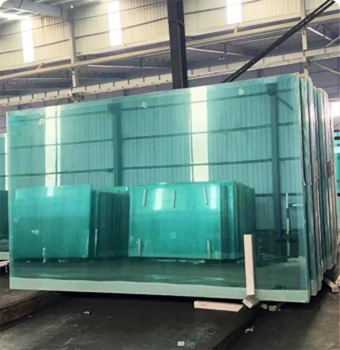Float Glass Production A Comprehensive Overview
Float glass is one of the most widely used types of glass in modern architecture and manufacturing, known for its superior optical clarity and flatness. The production of float glass involves a unique and highly controlled process that transforms raw materials into sheets of glass that are not only aesthetically pleasing but also remarkably functional. This article explores the intricacies of float glass production, from the raw materials used to the final product, and its various applications.
Raw Materials
The primary ingredients used in float glass production are silica sand, soda ash, and limestone. Silica sand provides the silica component, which is the main building block of glass. Soda ash acts as a flux, lowering the melting point of the sand, while limestone is added to improve the glass’s chemical durability and mechanical properties. Other additives may include alumina, magnesium, and various coloring agents, depending on the desired characteristics of the finished product.
The Float Process
The key innovation in float glass production is the 'float process,' developed in the 1950s by Sir Alastair Pilkington. This method revolutionized the glass industry by offering a way to produce large, flat sheets of glass with minimal surface imperfections.
1. Melting The production process begins in a furnace, where the raw materials are mixed and melted at temperatures ranging from 1,600°C to 1,700°C (about 2,912°F to 3,092°F). The high temperature ensures that the mixture becomes a homogeneous molten glass.
2. Floating Once the glass reaches its molten state, it is poured onto a molten tin bath. The glass floats on the tin due to its lower density. This floating action allows the glass to spread out evenly and form sheets with a thickness that can be controlled by adjusting the speed at which the glass flows across the tin bath.
3. Annealing After the desired thickness is achieved, the glass moves through a lehr, a controlled cooling chamber. This annealing process gradually reduces the temperature of the glass to room temperature, helping to relieve internal stresses and ensuring durability.
4. Cutting and Finishing The continuous ribbon of glass is then cut into sheets of various sizes according to market demands. These sheets may undergo additional treatments, such as surface coatings, tempering, or laminating, to enhance their properties for specific uses.
float glass production
Quality Control
Quality control is paramount in float glass production. Manufacturers employ various techniques to monitor the glass's thickness, clarity, and surface quality. Advanced technologies such as laser scanning and automated inspection systems are used to detect defects and ensure that the final product meets industry standards.
Applications
Float glass is employed in a wide array of applications, making it an essential material in construction and various industrial sectors. Its primary uses include
- Architectural Windows Float glass is the standard choice for windows in residential and commercial buildings, providing clarity and insulation.
- Doors and Partitions Used in both interior and exterior applications, float glass enhances aesthetic appeal while maintaining functionality.
- Automotive Industry The glass is utilized in windshields and windows, where it provides visibility and safety.
- Furniture and Interiors Manufacturers use float glass for tabletops, shelves, and decorative elements due to its sleek appearance.
Environmental Considerations
As the demand for float glass continues to grow, so does the need for environmentally sustainable practices in its production. Manufacturers are increasingly focusing on reducing energy consumption and emissions throughout the process. The use of recycled glass, often referred to as cullet, is being integrated into the raw material mix, as it can significantly lower melting temperatures, thus conserving energy and reducing carbon footprints.
Conclusion
Float glass production is a sophisticated process that combines traditional craftsmanship with modern technology. The versatility of float glass makes it indispensable in various industries, especially construction and automotive. As innovations continue to emerge, the float glass industry is poised to evolve, meeting the demands for higher efficiency and sustainability in the years to come. With its combination of beauty, strength, and functionality, float glass will undoubtedly remain a crucial component of our built environment.
 Afrikaans
Afrikaans  Albanian
Albanian  Amharic
Amharic  Arabic
Arabic  Armenian
Armenian  Azerbaijani
Azerbaijani  Basque
Basque  Belarusian
Belarusian  Bengali
Bengali  Bosnian
Bosnian  Bulgarian
Bulgarian  Catalan
Catalan  Cebuano
Cebuano  Corsican
Corsican  Croatian
Croatian  Czech
Czech  Danish
Danish  Dutch
Dutch  English
English  Esperanto
Esperanto  Estonian
Estonian  Finnish
Finnish  French
French  Frisian
Frisian  Galician
Galician  Georgian
Georgian  German
German  Greek
Greek  Gujarati
Gujarati  Haitian Creole
Haitian Creole  hausa
hausa  hawaiian
hawaiian  Hebrew
Hebrew  Hindi
Hindi  Miao
Miao  Hungarian
Hungarian  Icelandic
Icelandic  igbo
igbo  Indonesian
Indonesian  irish
irish  Italian
Italian  Japanese
Japanese  Javanese
Javanese  Kannada
Kannada  kazakh
kazakh  Khmer
Khmer  Rwandese
Rwandese  Korean
Korean  Kurdish
Kurdish  Kyrgyz
Kyrgyz  Lao
Lao  Latin
Latin  Latvian
Latvian  Lithuanian
Lithuanian  Luxembourgish
Luxembourgish  Macedonian
Macedonian  Malgashi
Malgashi  Malay
Malay  Malayalam
Malayalam  Maltese
Maltese  Maori
Maori  Marathi
Marathi  Mongolian
Mongolian  Myanmar
Myanmar  Nepali
Nepali  Norwegian
Norwegian  Norwegian
Norwegian  Occitan
Occitan  Pashto
Pashto  Persian
Persian  Polish
Polish  Portuguese
Portuguese  Punjabi
Punjabi  Romanian
Romanian  Russian
Russian  Samoan
Samoan  Scottish Gaelic
Scottish Gaelic  Serbian
Serbian  Sesotho
Sesotho  Shona
Shona  Sindhi
Sindhi  Sinhala
Sinhala  Slovak
Slovak  Slovenian
Slovenian  Somali
Somali  Spanish
Spanish  Sundanese
Sundanese  Swahili
Swahili  Swedish
Swedish  Tagalog
Tagalog  Tajik
Tajik  Tamil
Tamil  Tatar
Tatar  Telugu
Telugu  Thai
Thai  Turkish
Turkish  Turkmen
Turkmen  Ukrainian
Ukrainian  Urdu
Urdu  Uighur
Uighur  Uzbek
Uzbek  Vietnamese
Vietnamese  Welsh
Welsh  Bantu
Bantu  Yiddish
Yiddish  Yoruba
Yoruba  Zulu
Zulu 

